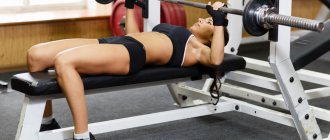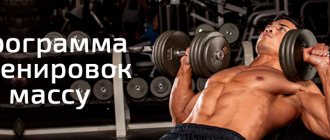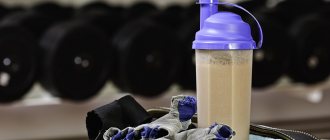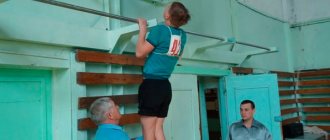Programming
Most often, split programs are developed on the “push-pull” principle. This means working on pulling muscles in one session and pushing muscles in another.
The most effective three-day splits are:
- back muscles - biceps;
- pectoral muscles - triceps;
- legs - shoulders.
Another option allows pumping:
- back – triceps;
- pectoral muscles - shoulders;
- leg muscles - shoulders.
Split option three:
- back - chest;
- arms - shoulders;
- legs.
Option four:
- dorsal muscles - biceps - rear deltoids;
- chest - triceps - anterior deltoids;
- legs.
Training schemes are numerous and the question of choice often arises. Each of the options is, of course, worthy of attention, but is not without its drawbacks. The best three-day weight split should best suit the athlete, taking into account individual characteristics.
The basic principles are as follows:
- Work each muscle group once, but seven days in advance.
- Working out the biceps is mandatory along with the back. It is advisable to devote the last stage of training to these muscles.
- According to the previous rule, the chest and triceps muscles are worked out.
- Work on the legs is combined with pumping up the shoulders. This provides a good anabolic response. The deltoid muscles receive a powerful developmental stimulus.
What is a 3 day split?
The training scheme assumes that a person works out in the gym 3 times a week. That is why it is becoming increasingly popular among professionals and beginners.
Classes using the 3-day split system involve dividing muscles into groups. At each training session, the athlete works only one of them. During the week, all muscles are used, and only once. So, one day is dedicated to the biceps and back, the second to the triceps and chest, the third to the shoulders and legs. The scheme is adjusted based on the individual characteristics of the person and the result he wants to get.
Previously, bodybuilders tried to pump up all their muscles in one workout. Such programs are imperfect. If an athlete performs many exercises and performs a large number of approaches, increased loads quickly lead to fatigue. The latest exercises no longer provide proper muscle pumping.
Therefore, exhausting and ineffective workouts were replaced by a 3-day split. It is based on separate pumping of individual muscle groups. The body has time to rest and recover between classes. Training becomes more effective and requires less time.
3 day split
Features of choice
When drawing up a program, professionals take into account many factors: gender implies a difference for men's and women's training. Men and women pursue different goals, and also have different muscle corset structures.
Girls often need to get rid of excess weight and add definition to their torso. Men are engaged in building their own figure, providing bulges to their biceps and building building blocks to their abs.
Split training is rarely recommended for beginners. All muscle groups should be worked out at least during one session. Otherwise, it is impossible to ensure balanced and uniform development of the body. You can switch to split classes with increased endurance and strength indicators.
Body type divides people into three types: ectomorphs, endomorphs, mesomorphs. Some people improve quickly, while for others the sport is an overwhelming task. The approach to training should be individual, but there are general recommendations related to physique.
Ectomorph
Men with this body type are characterized by a thin figure and thin, long limbs. People can gain weight for a long time because they have excellent metabolism. However, the right approach to training turns disadvantages into positive qualities. A three-day split for weight gain is recommended for ectomorphs if:
- basic exercises are used;
- The duration of the lesson does not exceed 45 minutes;
- repetition of exercises for each group 6-8 times for 4-6 approaches.
Alexander Shestov
TRX Certified Trainer
Ask a Question
The results from such physical activity will be maximum. The main thing is to follow the rule: more does not mean better.
Mesomorph
These people naturally have strong muscles, so muscle mass increases quickly during exercise. Forming a beautiful body for such people will not take much time. The mass split program involves:
- 8-12 repetitions of one exercise; in 6-8 approaches;
- inclusion of special exercises that improve muscle forms;
- inclusion of not one, but 2-3 groups of muscle tissue.
Endomorph
These are people who tend to be overweight, so they quickly gain weight, especially in the hips and abdomen, which negatively affects the shape of the chest and shoulders. The basis of an endomorph's training should be heavy exercise that ensures maximum calorie burning. Ultimately, it is necessary to achieve muscle mass growth. To do this, you need to allocate a minimum of time for rest between approaches, for example, no more than 60-90 seconds. It is enough to allocate from 90 to 120 minutes for one workout.
For training to be truly effective, it is better to conduct it with competent instructors, especially at the initial stage of training.
Training scheme for beginners
Training scheme for beginners
Beginner athletes and those who have not exercised for a long time should start by working out all the muscles in one workout. They should do an exercise for each muscle group in 3 sets. During the first week you need to conduct 2-3 such trainings. It is recommended to do different exercises on each of them. This will ensure balanced and uniform muscle development. Another plus is that a variety of exercises will make the training interesting, it won’t get boring.
You can't train to the point of exhaustion. A 3-day split involves varying the intensity of exercise - the weight of the weights and the number of repetitions. It's worth doing a light, medium, and hard workout every week.
Gradually, strength and endurance will increase. You will realize that it is impossible to load your entire body in one workout. You will have to increase the number of exercises for each muscle group and the duration of training. There will only be 3 gym classes each week. There is a possibility that the athlete will overtrain. Progress in strength and mass will end, it will be replaced by stagnation.
To prevent this from happening, you should move to a new stage - the “top-bottom” split: one day to devote to working the muscles of the upper body, the other to the lower part. You can continue doing just 3 workouts per week. The training schedule should be as follows: the first week - top - bottom - top, the second - bottom - top - bottom.
Over time, this training scheme will also become insufficiently effective. From this moment on, they switch to a 3-day split. You can train according to the following scheme:
- Monday: working out the pectoral muscles, deltoids (middle and anterior fascicles), triceps.
- Wednesday: training the back, deltoids (posterior fascicles), trapezius and biceps.
- Friday: working out the quadriceps, hamstrings, calves and abs.
After training the leg muscles, take a two-day break. Such activities are the most energy-consuming. It takes longer for the nervous system to recover.
Within one lesson, a 3-day split combines synergistic muscles - working in pairs. Thus, when performing exercises to develop the pectoral muscles, the frontal heads of the deltoid muscles and triceps are actively involved. They warm up and are loaded to a certain extent. When starting to work through them, it will be enough to perform 1-2 exercises.
You can swap training for legs and back, rear deltoids, and biceps. In this case, after working out the leg muscles, you need to rest for a couple of days. Training is also allowed for two days in a row according to the following scheme:
- Monday - chest and synergistic muscles.
- Tuesday - legs.
- Wednesday and Thursday are rest.
- Friday - back and synergistic muscles.
Training complex
Taking into account the characteristics of the athlete, you can choose one of the following training complexes. For example, in order for a fairly thin person to be able to properly pump up the body, it is necessary to choose the following exercises, which are performed in 8 repetitions and three approaches:
- squat;
- leg press;
- dumbbell press;
- barbell bench press.
The next day you can use a different set of movements:
- barbell bench press;
- French press;
- dips;
- extension of arms and legs.
Another workout involves:
- pull-ups;
- barbell row;
- deadlift;
- lifting weights on the biceps.
For mesomorphs, in addition to these exercises, you can immediately include loads on the crossbar and abdominal exercises. The number of repetitions here varies from 10 to 12, and there are three approaches.
The training complex for the endomorph involves 12-15 repetitions in 4 approaches. You can get in shape with the following exercises:
- squats;
- leg extensions;
- leg press;
- pumping the press;
- dumbbell press from a seated position.
Jumping rope and jogging should take about ten minutes of time and are the main requirement of all training days.
Recommendations for different body types
Read more about this classification in a separate material on somatotypes.
Ectomorph
Thin people with thin bones, underdeveloped muscle corset and low subcutaneous body fat:
- Nutrition . To gain weight, you need a high-calorie diet (more than 3300 kcal/day). The basis of the menu should be “complex” carbohydrates: cereals, durum wheat pasta, whole grain bread. Proteins and fats should be consumed in approximately equal proportions. You need to eat several times a day. If you can’t increase your body weight, you can use sports nutrition: creatine, gainers.
- Physical exercise . For ectomorphs, it is not advisable to get involved in aerobic training. Classes should be based on basic elements (deadlift, bench press, squat). Exercises should be distributed over 3 sessions per week, that is, the preferred type of training for the ectomorphic type is a three-day split with pauses of 1-2 days.
Mesomorph
Physically developed, strong people, most predisposed to strength training:
- Nutrition . The basis of a mesomorph’s diet should be protein foods: red meat, poultry, fish, cottage cheese. Menu calorie content: 3200–3400 kcal/day. People with a mesomorphic body type need to reduce carbohydrates and fats in their diet. Recommended supplements: vitamins, protein mixtures.
- Physical exercise . The basis of mesomorph training is the same strength elements: squats, bench presses, deadlifts. Exercises should be divided into 3 sessions. At the same time, a three-day split training for men should be strength training, that is, in each approach you need to select the weight so that failure is felt at 7-8 repetitions. In addition to the basic elements, you should select “complementary” exercises that promote maximum blood supply to the muscles. Rest between classes - 1-2 days.
Endomorph
Large-boned people with a high percentage of subcutaneous fat and weak, undeveloped muscles:
- Nutrition . The diet should be divided into small portions. Low calorie content: no more than 1800 kcal/day. The basis of the menu should be lean proteins (chicken fillet, eggs without yolks, fish, low-fat cottage cheese) and vegetable fiber (fruits, vegetables, herbs). The amount of carbohydrate food should be reduced to 15% of the daily value. Recommended supplements: vitamins, fat-burning complexes, high-quality protein isolates.
- Physical exercise . The training program should be drawn up for three days a week. It is recommended that these classes be carried out in an aerobic mode, aimed at burning fat and tightening the body (for example, aerobics, circuit training). If an athlete wants to train using the split method, the weights should be selected so that the approaches are multi-repetitive (15–20 times). The break between classes is 1 day. During recovery periods, you can do cardio exercises outside (for example, cycling or a light jog in the park).
As a rule, mixed body types predominate among people, for example, ectomorph-mesomorph. To more accurately determine your body type and create an effective training program, we recommend contacting a professional fitness trainer.
By the way, split training for girls is not much different from men’s; adjustments are made only for the weight of the equipment.
Disadvantages of a three-day split
The main significant drawback of the newest methodology is the lack of narrow specialization, so split can be called homework. A reduced number of exercises does not allow maximum load on a specific muscle group. Insufficient response is associated with insignificant resources of the human body.
Taking into account the activity of the endocrine mechanism, large muscle groups have a better recovery rate. The shoulders are a large group, so it is best to work it together with the legs, but on the limbs together with the biceps there may simply not be enough strength. Even experienced athletes often forget about this feature.
Small muscle groups are trained with special isolation exercises, so the bulk of the strength should go to large muscle groups.
During split training, arms receive the least amount of attention to develop and increase total muscle mass. You can completely leave one training day for hands-on training. During this workout, all movements should be aimed at strengthening the upper body. As a result, development and progression will occur without problems.
Ask your question to the coach:
Split to ground
Once your body adapts to the 3-day split, it's time to upgrade. Training will continue in a similar pattern, but with an increase in the number of exercises to 4 for large muscles and 2-3 for small ones. Another option is classes according to this scheme:
- Monday: chest muscles and biceps.
- Tuesday: quadriceps, hamstrings, calves and abdominal muscles.
- Friday: back, deltoids and triceps.
In this version of the 3-day split, the deltoid muscles are worked on the same days when the back and triceps are trained. Possible early fatigue of the triceps muscles of the shoulders. To prevent this, the deltoids are trained using dumbbell lifts, avoiding bench presses. Another option is to do dumbbell presses at the end of the deltoids. In this case, the weight will not be so large. Warm up your triceps before your workout.
Typical beginner mistakes[edit | edit code]
- Attempts to copy exercises performed by more experienced athletes. This doesn't lead to anything good. Experienced athletes have completely different goals and objectives, and blindly copying the exercises they perform may not give anything to novice athletes, or lead them to overtraining.
- The same applies to beginners copying the training programs of more experienced athletes, and even more so when copying the programs of professionals. This is guaranteed to drive the beginner into overtraining, stagnation of results and, as a result, disappointment in the training and abandonment of it. It's better to undertrain than to overtrain.
- Excessive use of isolation exercises. Isolation exercises performed for large muscle groups will not give a beginner anything in terms of gaining mass and strength. According to the author, beginners can only use them to work out small muscle groups - deltoids, biceps, triceps, etc.
- Lifting heavy weights at the expense of proper technique. Firstly, it is fraught with injury. Secondly, incorrect exercise technique shifts part of the load onto other, non-target muscles, as a result of which the muscles being worked do not receive enough load. Leave your ego outside the room. All exercises must be performed under control, at a smooth pace, avoiding sudden movements. Change phases of movement smoothly. When doing presses, do not allow the bar to hit your chest; when doing deadlifts, do not pull the weight from the starting point, but gradually apply force.
- Increasing the intensity of training through various methods of increasing intensity. At this stage, only one method of increasing intensity is possible - increasing the working weights in the exercises. All other methods, such as supersets, drop sets, cheating, forced repetitions and other techniques, are unacceptable at this stage.
- Using “failure” reps. This greatly overloads the psyche, will do nothing for strength and can lead to stagnation in results. You need to finish the set a couple of reps before failure.
- Go below 5-6 reps per set. Your strength is already growing. A low number of repetitions with a large weight puts a lot of stress on the joint-ligamentous system, which does not progress as quickly as the muscles. Therefore, attempting to lift excessively heavy weights at this stage may result in serious joint or ligament injury.
- Excessive delay in training. One hour is enough to complete the above programs.
- In conclusion, let me remind you of the saying: the quieter you drive, the further you will go.
Conclusion[edit | edit code]
I would like to note that many athletes, including very famous ones, have been training on a three-day split for years and decades, progressing at the same time, especially in the off-season, when the goal is not to participate in competitions. At the same time, the above-written split programs vary in different ways; the methods described in the article Effective principles of gaining muscle mass are used. However, increased working weights in exercises and the use of intensification training methods make it quite difficult to fully train two muscle groups in one workout, as happens in a three-day split, and, in addition, significantly lengthen this workout. Therefore, many athletes switch to a Four-Day Split or a Five-Day Split
Special training program for girls
Fitness experts recommend that girls load all their muscles in one session, training 2-3 times a week. Then you should switch to the “top-bottom” split according to the same scheme. It is better for girls to start training according to the 3-day split system after a couple of years of regular training. The standard scheme is as follows:
- Monday: back, buttocks and hamstrings.
- Wednesday: chest, arms and shoulders.
- Friday: front and back thighs, calves and abdominal muscles.
A 3-day split assumes that exercises are performed in at least 3 sets of 10-15 sets.
1 workout
Back:
- Pull-ups.
- Belt rows while sitting on a machine.
- Bent-over dumbbell rows, leaning on a bench.
Hips and buttocks:
- Deadlift on straight or slightly bent legs.
- Reverse hyperextension in a superset with a regular one.
- Breeding legs on the simulator.
2 training
Breast:
- Raising your arms with dumbbells to the sides while lying on an inclined bench.
Deltoids:
- Swing dumbbells from side to side, bending over.
- Swing with dumbbells in front of you.
- Seated dumbbell press.
Triceps and biceps:
1. Bend your elbows with dumbbells while lying on an inclined bench plus extensions on the upper block.
2. Curling the arms with a barbell plus extension of the arms from behind the head on the lower block.
What is the essence of splits?
Split is a type of strength training that involves simultaneous loading of several muscle groups on days of the week. Consequently, in one day you do not work on the entire body, but only on individual muscle groups.
The two main advantages of this method, which ensure its high effectiveness in bodybuilding, are related to the fact that split allows you to concentrate on each muscle group, working them more thoroughly than during training for the whole body. Also, you have more days to recover and grow muscle fibers.
If you read my previous post about the 4-Day Split program, you know that the two most important aspects of building muscle, along with a balanced diet, are training intensity and adequate rest.
A three-day split meets all these requirements. Moreover, this system is very easy and convenient to practice. Personally, I alternate between three-day and four-day splits: 90 days I do the first program, and 90 days the second, and so on in a circle. For me this is the best mode.
General recommendations[edit | edit code]
You can still come up with and implement many three-day splits, and all will have some advantages or disadvantages. A guideline here may be to place the lagging muscle group on a separate training day and draw up a split according to this condition. Consideration of them is beyond the scope of this article. The general training rules at this stage are standard. General warm-up and light stretching to prepare the body for power loads. A special warm-up in one or two approaches with light weight before performing each exercise. The pace of execution is average, without jerking or beating the barbell against the chest. Rest time between sets is 2-3 minutes.
Split on relief
During the drying period, the 3-day split remains the same as during weight gain. It is enough to increase the weight of the weights and reduce the number of repetitions to 6-8 in one approach. This will allow you to maintain muscle mass while following a reduced-calorie diet, which is necessary to get rid of fat deposits.
After weight training, you need to switch to cardio training. During this period, the body is tuned to burning fat - glycogen reserves are partially used up. You can do cardio in the morning on an empty stomach or follow this 3-day split program:
- Monday: chest and back muscles.
- Tuesday: quadriceps, hamstrings, calves, abdominal muscles.
- Friday: arms and shoulders.
To increase the energy intensity of weight training, you need to do supersets, triples and giant sets. When working your back and chest, you can combine exercises: do a set of exercises for the back, and after a couple of minutes - for the chest. Working weights need to be reduced slightly.
An effective set of exercises for the quadriceps, which specifically works different areas of the front surface of the thighs:
- Squats with a barbell on your shoulders.
- Sissy squats.
- Leg extensions on the machine.
Within each approach, you need to do 10-12 repetitions of the exercise without breaks. After 5 minutes, you should do another 3-5 repetitions.
Supersets for working out the hamstrings:
- Deadlift on straight legs.
- Bend your knees while lying on a machine.
Trisets:
1. Bend your knees while lying on the machine.
2. The same, standing on the simulator.
3. Step-up (stepping onto the bench with each foot in turn).
Giant set for working deltoid muscles:
- Swing your arms across the sides with dumbbells, bending over.
- The same in a sitting position.
- Swing your arms with dumbbells in front of you while sitting.
- Seated dumbbell press.
Supersets are suitable for working out biceps and triceps.











